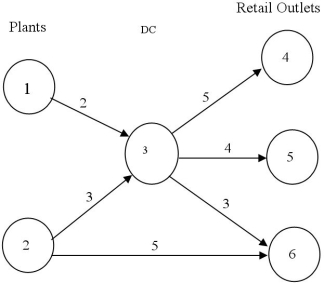Consider the following network representation of shipment routes between plants, a distribution center, and retail outlets. The numbers next to the arcs represent shipping costs. For example, the cost of shipping from plant 1 to distribution center 3 is equal to $2.
 Assume that Plant 1 can supply 400 units and Plant 2, 500 units. Demand at the retail outlets are: Outlet 4, 300 units; Outlet 5, 250 units; Outlet 6, 450 units.
Assume that Plant 1 can supply 400 units and Plant 2, 500 units. Demand at the retail outlets are: Outlet 4, 300 units; Outlet 5, 250 units; Outlet 6, 450 units.
-Which constraint represents transshipment through the distribution center?
Definitions:
Rate Variance
The difference between the expected rate of return on a project or investment and the actual rate achieved.
Total Direct Labor Cost Variance
The difference between the actual cost of direct labor used in production and the expected (or standard) cost.
Materials Price Variance
The difference between the actual cost of materials and the expected cost at standard prices, indicating how much was saved or overspent.
Materials Quantity Variance
The difference between the actual quantity of materials used in production and the standard quantity expected to be used, valued at the standard cost.
Q19: If t is the expected completion time
Q20: In PERT, the path with the fewest
Q21: Goal constraints can include _ deviational variables.<br>A)
Q37: In a transshipment problem, items may be
Q42: If we are solving a 0-1 integer
Q68: The Lagrange multiplier is _ to the
Q76: A script writer has received an advance
Q87: This linear programming problem is a(n)<br>A) maximization
Q90: Draw the network associated with the following
Q93: A(n) _ measures the degree of inconsistency